Kunpeng Zhang
TreeHop: Generate and Filter Next Query Embeddings Efficiently for Multi-hop Question Answering
Apr 30, 2025Abstract:Retrieval-augmented generation (RAG) systems face significant challenges in multi-hop question answering (MHQA), where complex queries require synthesizing information across multiple document chunks. Existing approaches typically rely on iterative LLM-based query rewriting and routing, resulting in high computational costs due to repeated LLM invocations and multi-stage processes. To address these limitations, we propose TreeHop, an embedding-level framework without the need for LLMs in query refinement. TreeHop dynamically updates query embeddings by fusing semantic information from prior queries and retrieved documents, enabling iterative retrieval through embedding-space operations alone. This method replaces the traditional "Retrieve-Rewrite-Vectorize-Retrieve" cycle with a streamlined "Retrieve-Embed-Retrieve" loop, significantly reducing computational overhead. Moreover, a rule-based stop criterion is introduced to further prune redundant retrievals, balancing efficiency and recall rate. Experimental results show that TreeHop rivals advanced RAG methods across three open-domain MHQA datasets, achieving comparable performance with only 5\%-0.4\% of the model parameter size and reducing the query latency by approximately 99\% compared to concurrent approaches. This makes TreeHop a faster and more cost-effective solution for deployment in a range of knowledge-intensive applications. For reproducibility purposes, codes and data are available here: https://github.com/allen-li1231/TreeHop-RAG.
One-Point Sampling for Distributed Bandit Convex Optimization with Time-Varying Constraints
Apr 24, 2025Abstract:This paper considers the distributed bandit convex optimization problem with time-varying constraints. In this problem, the global loss function is the average of all the local convex loss functions, which are unknown beforehand. Each agent iteratively makes its own decision subject to time-varying inequality constraints which can be violated but are fulfilled in the long run. For a uniformly jointly strongly connected time-varying directed graph, a distributed bandit online primal-dual projection algorithm with one-point sampling is proposed. We show that sublinear dynamic network regret and network cumulative constraint violation are achieved if the path-length of the benchmark also increases in a sublinear manner. In addition, an $\mathcal{O}({T^{3/4 + g}})$ static network regret bound and an $\mathcal{O}( {{T^{1 - {g}/2}}} )$ network cumulative constraint violation bound are established, where $T$ is the total number of iterations and $g \in ( {0,1/4} )$ is a trade-off parameter. Moreover, a reduced static network regret bound $\mathcal{O}( {{T^{2/3 + 4g /3}}} )$ is established for strongly convex local loss functions. Finally, a numerical example is presented to validate the theoretical results.
Enhancing Investment Analysis: Optimizing AI-Agent Collaboration in Financial Research
Nov 07, 2024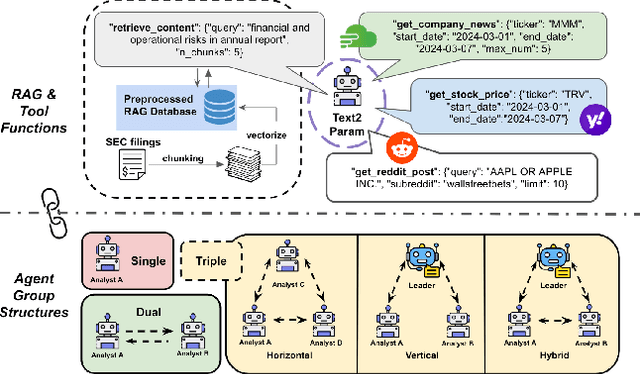
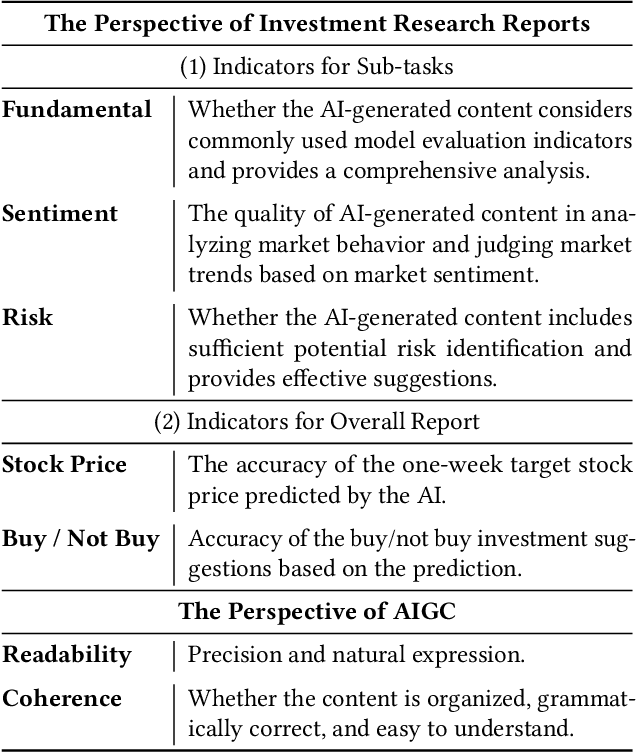
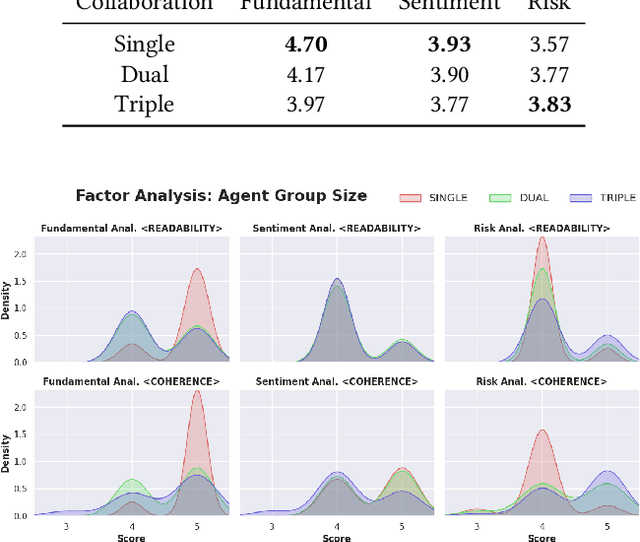
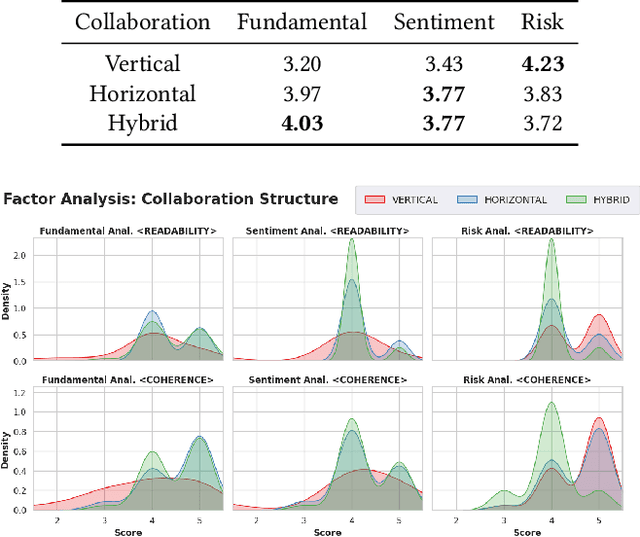
Abstract:In recent years, the application of generative artificial intelligence (GenAI) in financial analysis and investment decision-making has gained significant attention. However, most existing approaches rely on single-agent systems, which fail to fully utilize the collaborative potential of multiple AI agents. In this paper, we propose a novel multi-agent collaboration system designed to enhance decision-making in financial investment research. The system incorporates agent groups with both configurable group sizes and collaboration structures to leverage the strengths of each agent group type. By utilizing a sub-optimal combination strategy, the system dynamically adapts to varying market conditions and investment scenarios, optimizing performance across different tasks. We focus on three sub-tasks: fundamentals, market sentiment, and risk analysis, by analyzing the 2023 SEC 10-K forms of 30 companies listed on the Dow Jones Index. Our findings reveal significant performance variations based on the configurations of AI agents for different tasks. The results demonstrate that our multi-agent collaboration system outperforms traditional single-agent models, offering improved accuracy, efficiency, and adaptability in complex financial environments. This study highlights the potential of multi-agent systems in transforming financial analysis and investment decision-making by integrating diverse analytical perspectives.
From Automation to Augmentation: Large Language Models Elevating Essay Scoring Landscape
Jan 12, 2024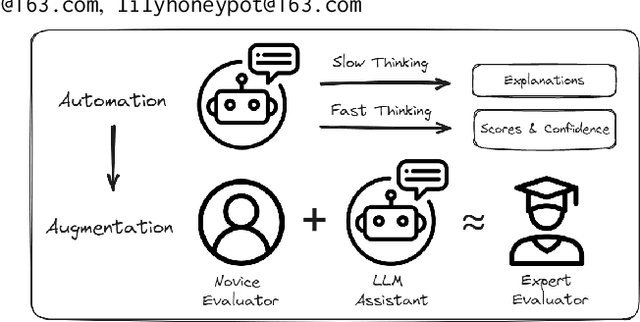
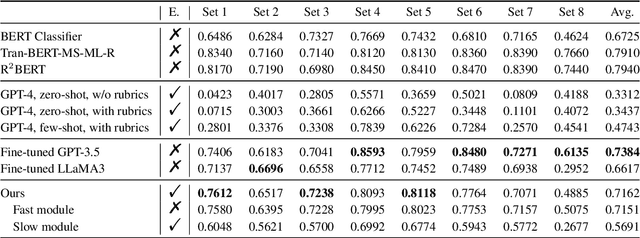

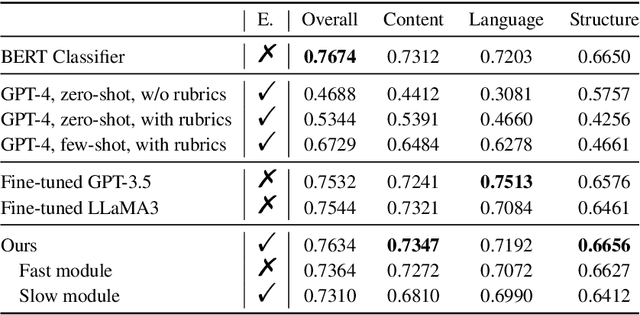
Abstract:Receiving immediate and personalized feedback is crucial for second-language learners, and Automated Essay Scoring (AES) systems are a vital resource when human instructors are unavailable. This study investigates the effectiveness of Large Language Models (LLMs), specifically GPT-4 and fine-tuned GPT-3.5, as tools for AES. Our comprehensive set of experiments, conducted on both public and private datasets, highlights the remarkable advantages of LLM-based AES systems. They include superior accuracy, consistency, generalizability, and interpretability, with fine-tuned GPT-3.5 surpassing traditional grading models. Additionally, we undertake LLM-assisted human evaluation experiments involving both novice and expert graders. One pivotal discovery is that LLMs not only automate the grading process but also enhance the performance of human graders. Novice graders when provided with feedback generated by LLMs, achieve a level of accuracy on par with experts, while experts become more efficient and maintain greater consistency in their assessments. These results underscore the potential of LLMs in educational technology, paving the way for effective collaboration between humans and AI, ultimately leading to transformative learning experiences through AI-generated feedback.
Multimodal Data Augmentation for Image Captioning using Diffusion Models
May 03, 2023
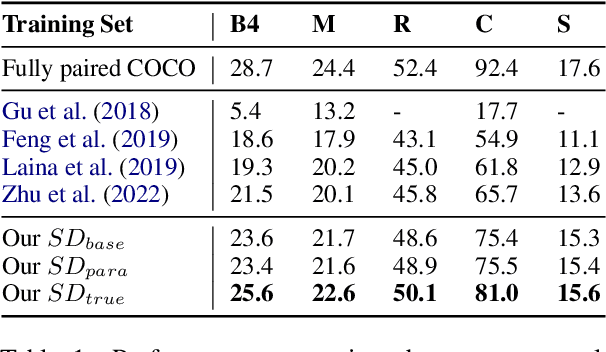
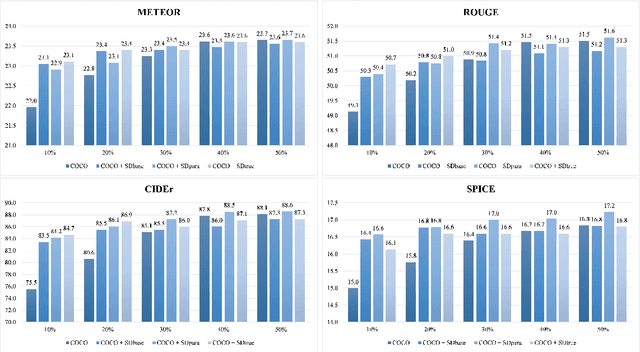
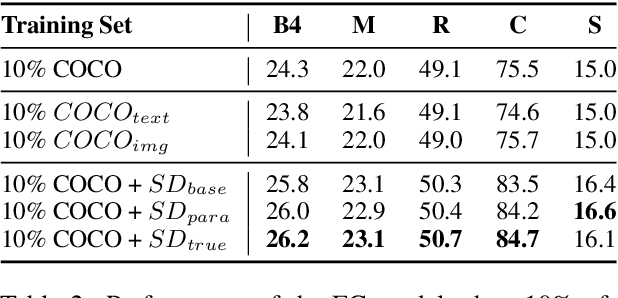
Abstract:Image captioning, an important vision-language task, often requires a tremendous number of finely labeled image-caption pairs for learning the underlying alignment between images and texts. In this paper, we proposed a multimodal data augmentation method, leveraging a recent text-to-image model called Stable Diffusion, to expand the training set via high-quality generation of image-caption pairs. Extensive experiments on the MS COCO dataset demonstrate the advantages of our approach over several benchmark methods, and particularly a significant boost when having fewer training instances. In addition, models trained on our augmented datasets also outperform prior unpaired image captioning methods by a large margin. Finally, further improvement regarding the training efficiency and effectiveness can be obtained after intentionally filtering the generated data based on quality assessment.
Large-Scale Traffic Data Imputation with Spatiotemporal Semantic Understanding
Jan 27, 2023Abstract:Large-scale data missing is a challenging problem in Intelligent Transportation Systems (ITS). Many studies have been carried out to impute large-scale traffic data by considering their spatiotemporal correlations at a network level. In existing traffic data imputations, however, rich semantic information of a road network has been largely ignored when capturing network-wide spatiotemporal correlations. This study proposes a Graph Transformer for Traffic Data Imputation (GT-TDI) model to impute large-scale traffic data with spatiotemporal semantic understanding of a road network. Specifically, the proposed model introduces semantic descriptions consisting of network-wide spatial and temporal information of traffic data to help the GT-TDI model capture spatiotemporal correlations at a network level. The proposed model takes incomplete data, the social connectivity of sensors, and semantic descriptions as input to perform imputation tasks with the help of Graph Neural Networks (GNN) and Transformer. On the PeMS freeway dataset, extensive experiments are conducted to compare the proposed GT-TDI model with conventional methods, tensor factorization methods, and deep learning-based methods. The results show that the proposed GT-TDI outperforms existing methods in complex missing patterns and diverse missing rates. The code of the GT-TDI model will be available at https://github.com/KP-Zhang/GT-TDI.
Incorporating Interactive Facts for Stock Selection via Neural Recursive ODEs
Oct 28, 2022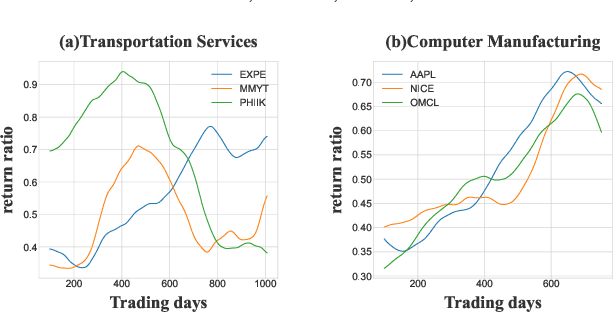

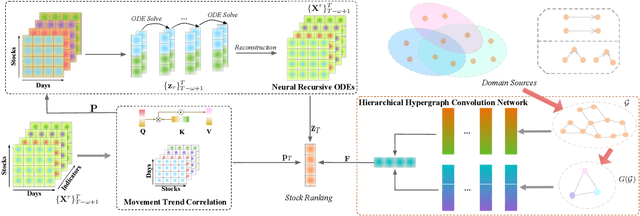

Abstract:Stock selection attempts to rank a list of stocks for optimizing investment decision making, aiming at minimizing investment risks while maximizing profit returns. Recently, researchers have developed various (recurrent) neural network-based methods to tackle this problem. Without exceptions, they primarily leverage historical market volatility to enhance the selection performance. However, these approaches greatly rely on discrete sampled market observations, which either fail to consider the uncertainty of stock fluctuations or predict continuous stock dynamics in the future. Besides, some studies have considered the explicit stock interdependence derived from multiple domains (e.g., industry and shareholder). Nevertheless, the implicit cross-dependencies among different domains are under-explored. To address such limitations, we present a novel stock selection solution -- StockODE, a latent variable model with Gaussian prior. Specifically, we devise a Movement Trend Correlation module to expose the time-varying relationships regarding stock movements. We design Neural Recursive Ordinary Differential Equation Networks (NRODEs) to capture the temporal evolution of stock volatility in a continuous dynamic manner. Moreover, we build a hierarchical hypergraph to incorporate the domain-aware dependencies among the stocks. Experiments conducted on two real-world stock market datasets demonstrate that StockODE significantly outperforms several baselines, such as up to 18.57% average improvement regarding Sharpe Ratio.
Self-supervised Representation Learning for Trip Recommendation
Sep 08, 2021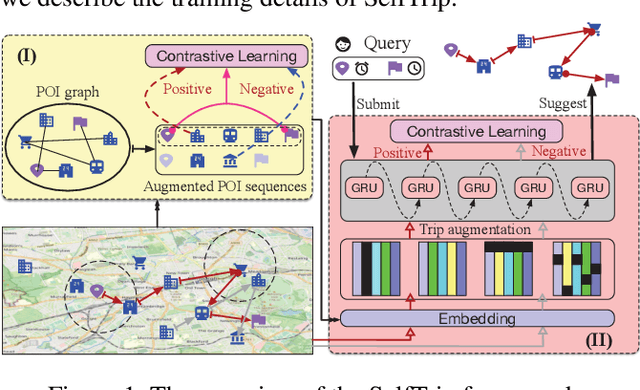

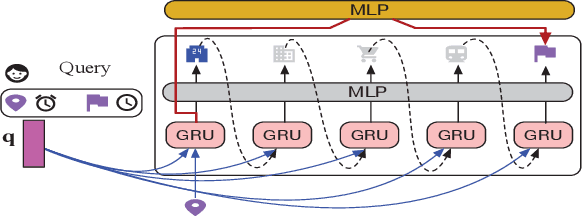
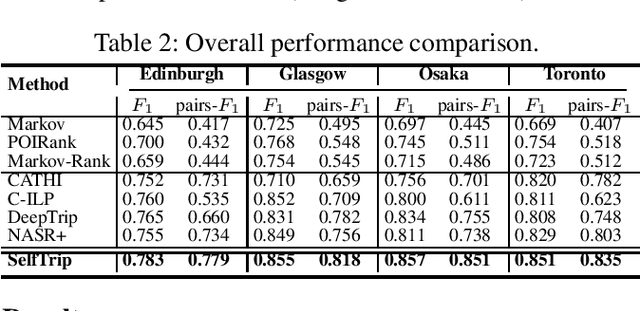
Abstract:Trip recommendation is a significant and engaging location-based service that can help new tourists make more customized travel plans. It often attempts to suggest a sequence of point of interests (POIs) for a user who requests a personalized travel demand. Conventional methods either leverage the heuristic algorithms (e.g., dynamic programming) or statistical analysis (e.g., Markov models) to search or rank a POI sequence. These procedures may fail to capture the diversity of human needs and transitional regularities. They even provide recommendations that deviate from tourists' real travel intention when the trip data is sparse. Although recent deep recursive models (e.g., RNN) are capable of alleviating these concerns, existing solutions hardly recognize the practical reality, such as the diversity of tourist demands, uncertainties in the trip generation, and the complex visiting preference. Inspired by the advance in deep learning, we introduce a novel self-supervised representation learning framework for trip recommendation -- SelfTrip, aiming at tackling the aforementioned challenges. Specifically, we propose a two-step contrastive learning mechanism concerning the POI representation, as well as trip representation. Furthermore, we present four trip augmentation methods to capture the visiting uncertainties in trip planning. We evaluate our SelfTrip on four real-world datasets, and extensive results demonstrate the promising gain compared with several cutting-edge benchmarks, e.g., up to 4% and 12% on F1 and pair-F1, respectively.
Enhanced Seq2Seq Autoencoder via Contrastive Learning for Abstractive Text Summarization
Aug 26, 2021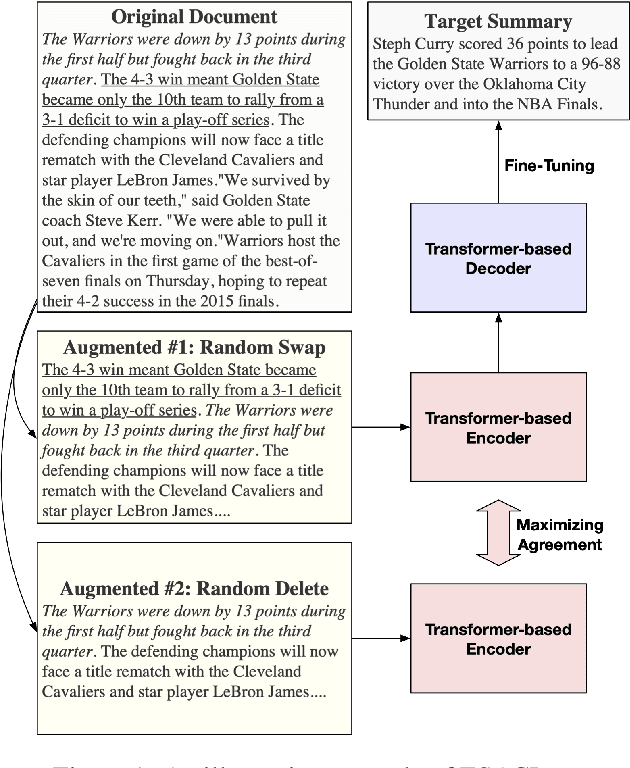
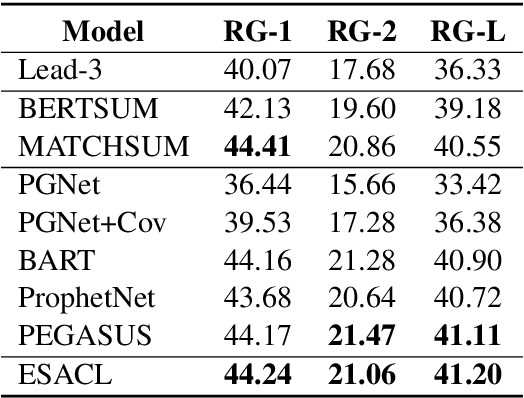

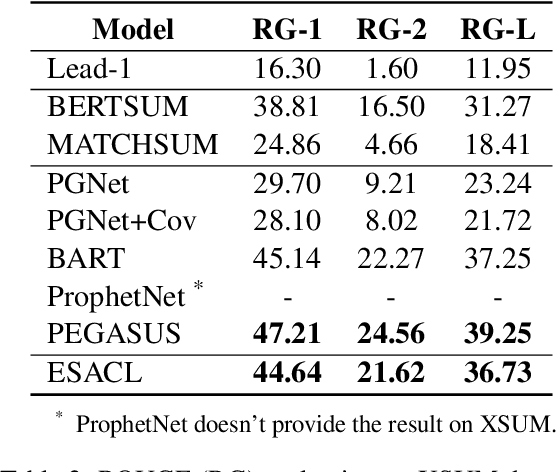
Abstract:In this paper, we present a denoising sequence-to-sequence (seq2seq) autoencoder via contrastive learning for abstractive text summarization. Our model adopts a standard Transformer-based architecture with a multi-layer bi-directional encoder and an auto-regressive decoder. To enhance its denoising ability, we incorporate self-supervised contrastive learning along with various sentence-level document augmentation. These two components, seq2seq autoencoder and contrastive learning, are jointly trained through fine-tuning, which improves the performance of text summarization with regard to ROUGE scores and human evaluation. We conduct experiments on two datasets and demonstrate that our model outperforms many existing benchmarks and even achieves comparable performance to the state-of-the-art abstractive systems trained with more complex architecture and extensive computation resources.
CCGL: Contrastive Cascade Graph Learning
Jul 27, 2021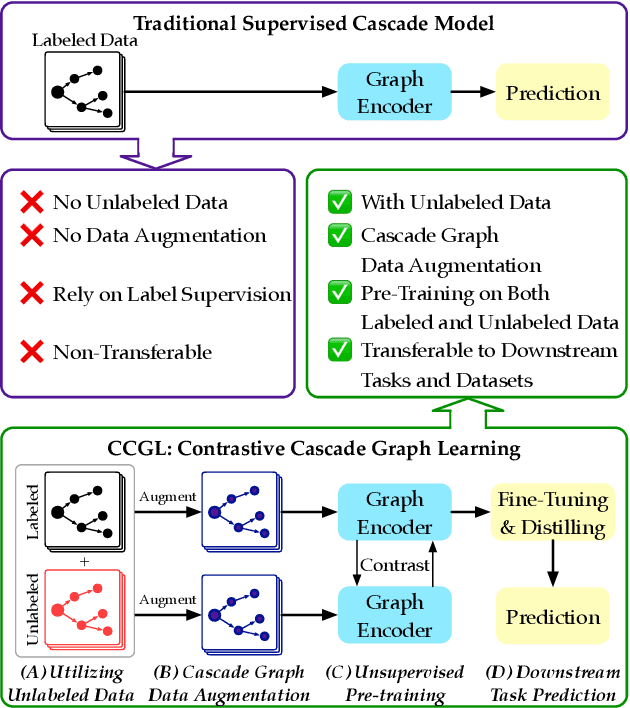
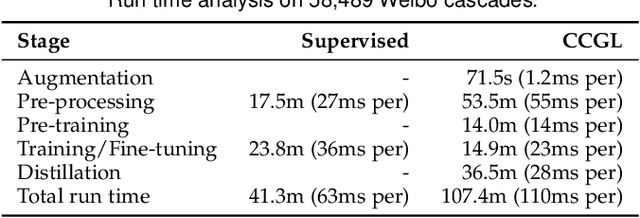
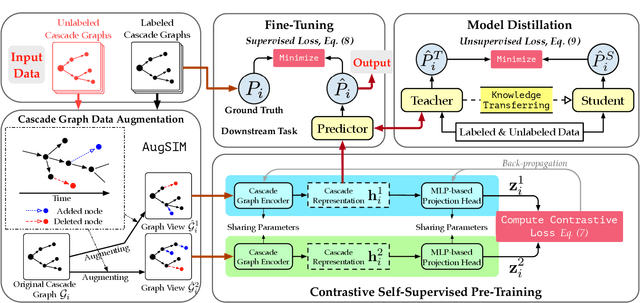

Abstract:Supervised learning, while prevalent for information cascade modeling, often requires abundant labeled data in training, and the trained model is not easy to generalize across tasks and datasets. Semi-supervised learning facilitates unlabeled data for cascade understanding in pre-training. It often learns fine-grained feature-level representations, which can easily result in overfitting for downstream tasks. Recently, contrastive self-supervised learning is designed to alleviate these two fundamental issues in linguistic and visual tasks. However, its direct applicability for cascade modeling, especially graph cascade related tasks, remains underexplored. In this work, we present Contrastive Cascade Graph Learning (CCGL), a novel framework for cascade graph representation learning in a contrastive, self-supervised, and task-agnostic way. In particular, CCGL first designs an effective data augmentation strategy to capture variation and uncertainty. Second, it learns a generic model for graph cascade tasks via self-supervised contrastive pre-training using both unlabeled and labeled data. Third, CCGL learns a task-specific cascade model via fine-tuning using labeled data. Finally, to make the model transferable across datasets and cascade applications, CCGL further enhances the model via distillation using a teacher-student architecture. We demonstrate that CCGL significantly outperforms its supervised and semi-supervised counterpartsfor several downstream tasks.
 Add to Chrome
Add to Chrome Add to Firefox
Add to Firefox Add to Edge
Add to Edge